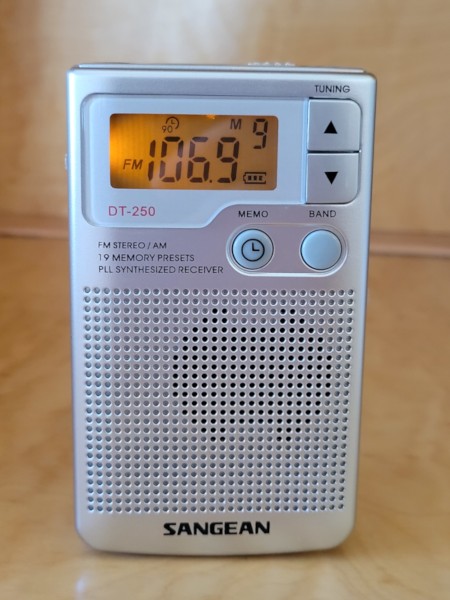
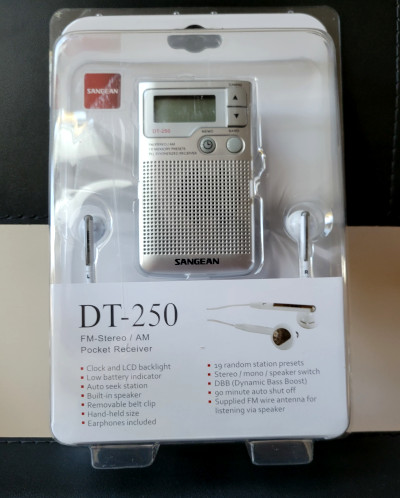
I really like radios with cabinets in a silver color, such as the Tecsun PL-310ET or the Elpa ER-C57WR from Japan. So when I learned about the existence of the Sangean DT-250, which strongly resembles the Sangean DT-200VX AM/FM/analog TV band radio (now available as the DT-200X) and the DT-400W AM/FM/weather band radio, I set about getting one.
It wasn't straightforward: the DT-250 is not sold in North America. It's intended for the rest of the world, most notably Europe and Australia.
Because the DT-250 resembles the DT-200VX and the DT-400W, I wondered if its performance was similar to those other two models: good AM performance but mediocre FM performance. (This DT-400W comparison is with an earlier version of that model; the version available in 2021 appears to have improved FM performance.) So I hesitated, but ultimately decided to go ahead with the purchase, using one of the European branches of Amazon. I paid way too much for shipping, but the radio arrived four days after I ordered it! The price was under $50, not counting shipping. We won't talk about how much shipping cost.
The radio arrived in the blister pack that you see at the top of this page on the right. The package includes an owner's manual, a plug-in FM antenna for use when the speaker is on, a pair of earbuds that are so-so (I don't like most earbuds and these are no exception), and cushions for those earbuds.
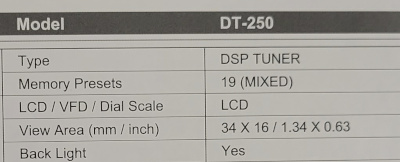
If, before writing this review, I had looked more closely at the card that was the backing for the blister pack (right), I would have seen that this is indeed a DSP-based radio. That's consistent with the strong FM performance of this unit. The newer version of the DT-400W model sold in North America may also be DSP-based, given that its performance is nearly identical to the DT-250. Unfortunately, I don't have any evidence to back up my conjecture, other than my experience with these radios.
On both AM and FM, the DT-250 is free from the artifacts that afflict some other DSP-based radios. AM-band reception is free from digital noises generated by the radio itself. On both AM and FM, the volume levels of very weak signals are not arbitrarily reduced (otherwise known as so-called "soft muting"). Unlike many other DSP-based radios, multiple bandwidth settings aren't available (this is also true of the DT-400W sold in North America).
Just as with its siblings, the DT-250 takes two AA batteries, with a battery compartment that's hinged so it won't come off. There's a yellow backlight that briefly comes on whenever a control is touched, and a clock that displays when the radio is off. There is no alarm function.
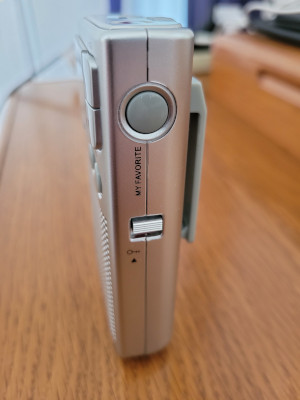
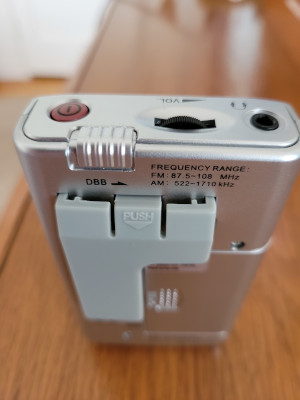
The controls are nearly identical to those on the Sangean DT-200VX, including a separate "band" called "My Favorites", with up to 19 memory presets, on either AM or FM, tuned with the "up" and "down" buttons on the front of the radio. There's no automatic search function. All memory settings have to be entered manually, just as on the DT-200VX and DT-400W.
As with those Sangean models, and some others, there's a Dynamic Bass Boost feature (DBB) that improves the bass response (switch pictured at near right). This is mostly effective when using headphones, but there's a subtle effect when listening to the built-in 1 3/8" (20.6 cm) speaker. There's a switch on the other side of the radio (not pictured) that selects between listening through the built-in speaker, and listening through headphones, either in mono or in stereo.
As an aside, in the owner's manual, most measurements are in English units, even in the parts of the manual in French, Spanish, and Dutch. Only the German-language section of manual gives measurements in metric units!
I've noted the similarities with the two Sangean models that I had purchased more than ten years earlier, the DT-200VX and the DT-400W. I assumed that the DT-250's performance would be similar, too.
Surprise!
The DT-250 is a better FM performer! I did a simple head-to-head comparison among the three Sangean models at midday in the summer. I also included the DSP-based DT-800 model, which also tunes AM, FM, and the North American weather-radio band. I counted a station as received if it could be heard steadily, even at low volume. This gives some idea of each radio's ability to pick up weaker signals. (Note: This comparison was done before I bought the newer version of the DT-400W, which performs nearly identically to the DT-250 on the AM and FM bands.)
- DT-200VX (AM/FM/old analog TV band): 30 AM stations, 30 FM stations.
- DT-400W, older version (AM/FM/weather band): 28 AM stations, 28 FM stations.
- DT-800 (AM/FM/weather band, using the wide bandwidth setting for both AM and FM): 33 AM stations, 49 FM stations.
- DT-250 (AM/FM): 30 AM stations, 46 FM stations.
AM (medium wave) performance among all models was reasonably similar. I would categorize AM reception on all the models tested as good. However, reception on the DT-250 and the DT-800 was affected much less from electrical interference than with the other two models.
On FM, the DT-250 was more selective than the DT-200VX and DT-400W (the 2011 version), making it less prone to interference from HD digital noise and enabling the radio to pick up stations in-between strong FM signals originating from San Francisco. Stations from San José as well as translators and low-power FMs that could not be heard on the DT-200VX or DT-400W were easily received on the DT-250 as well as the DT-800. I categorize the DT-250's FM performance as excellent.
Aside from not being generally available in North America, there's one other minor downside to the DT-250, relating to FM audio quality. FM stations use a fairly crude form of noise reduction that amounts to a giant treble control being cranked up. All FM radio receivers then have a simple compensating circuit to turn that treble back down. This is known as pre-emphasis (during transmission) and de-emphasis (during reception).
North American FM stations use more treble than FM stations in other parts of the world. Thus, a receiver intended for the U.S., Canada, and Mexico will crank that treble down more than receivers intended for use in other countries.
Thus, a receiver intended for use in Europe (or other countries) that's used in the United States will use less de-emphasis than a typical American radio. As a consequence, FM audio on such a receiver will sound a little bit "brighter" than usual. That's the case with the DT-250. This is not a huge problem, but some listeners may notice it, and may even be bothered by it. I notice it, but don't find it to be an issue. Turning on the Dynamic Bass Boost function also helps balance out the sound through headphones.
The radio arrived set for receiving AM stations allocated 9 kHz apart, the standard outside the Western Hemisphere. Using the same procedure as on the DT-200VX and DT-400W, the radio can be set for 10 kHz spacing:
- Turn the radio off.
- To go from 10 kHz to 9 kHz spacing, simultaneously press the power button and the up tuning button.
- To go from 9 kHz to 10 kHz spacing, simultaneously press the power button and the down tuning button.
This does not affect FM reception; for example, it doesn't alter the radio's FM de-emphasis. FM tuning steps are 100 kHz.
Was it worth going to the trouble to get this Sangean model? I don't regret the purchase at all. Even so, I think for most people in the U.S., Canada, or Mexico, the newer version of the DT-400W or the DT-800 would be a better choice. Those two models are widely available and can also receive National Weather Service or Environment Canada weather radio stations. The DT-250 doesn't have the weather-radio band because that band is used only in North America.
On the other hand, since the DT-250 is intended for use outside North America, it would be a good choice if you do a lot of international travel. In my opinion, it's also one of the most attractive Sangean pocket radios, thanks to its silver-colored finish.